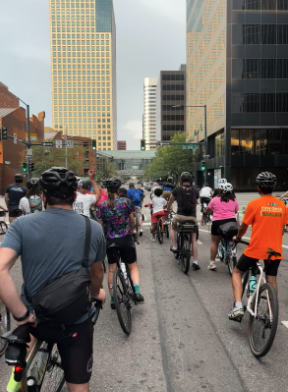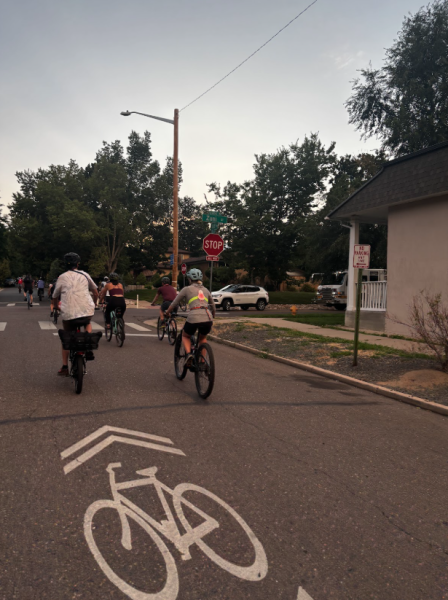
Participants in Critical Mass gather downtown
On Monday, July 21st at the intersection of 38th Avenue and Tejon Street, a student visiting from Turkey, later identified as 21 year old Salih Koc, was killed in a hit and run while riding his bicycle. On Friday, July 25th—just a few feet north of the same intersection— a group of cyclists held a moment of silence in remembrance of Koc, as well as two others killed in similar incidents in the Denver Metro Area that week. The demonstration was part of a monthly event called Denver Critical Mass, which organizer Joe Sak calls a leaderless ride aimed at allowing participants to experience safety in numbers and “the joy of being able to ride your bike through the city.” Sak called the event a turning point for him to start identifying Critical Mass as what it is: A protest. Sak, who revived the Denver Critical Mass ride last year, says he had previously shied away from using the word “protest” for fear of discouraging attendees due to the perceived negative connotations of the word. “After that happened” he said, “there was a switch in my mind that ‘No, this ride, it is a protest and I’m going to tell people that it is and we’re going to treat it that way.”
The first Critical Mass ride took place in San Francisco in 1992 with two goals in mind: To allow cyclists to ride in the street without risking their personal safety, and to force city planners to consider everyone, not just cars, in their decision making. Today, Critical Mass rides take place in cities all over the world, including Denver. Each one looks a little different; Denver’s takes place on the last Friday of every month and welcomes not only cyclists but people on rollerblades, e-bikes, scooters, or “anything that’s an efficiently sized vehicle and not polluting.” As Sak puts it, “streets are supposed to be filled with people doing people activities.” Sak, who also serves as Vice-Chair on the Mayor’s Bicycle Advisory Committee (MBAC), moved to Denver two years ago from Chicago, a city with its own very well established Critical Mass ride. He said he was surprised to find out that Denver had no current active ride. After getting in contact with the previous owner of the denvercriticalmass.org domain name through a friend, he was able to revive the Denver incarnation of Critical Mass, which he says has been growing consistently over the last year. He also talked about the culture of cruiser rides in Denver, which he speculates cropped up in part as a reaction to the perceived aggressiveness of Critical Mass movements saying “I like having a friendly, chill atmosphere too. I want people to feel welcome.” That vibe is in part cultivated by the ride’s unofficial catchphrase: “Happy Friday,” which participants bellow to bewildered tourists on 16th street and disgruntled motorists who sometimes get held up at intersections to ensure the entirety of the ride can pass through safely and without interruption.
This is another safety measure commonly employed on large group rides known as corking. Rides can grow to 100 or more participants meaning that to keep everyone together, it sometimes becomes necessary to pause traffic temporarily. Sak typically leads the ride from the front, so he relies heavily on volunteers to “cork” traffic with their bikes and their bodies. Volunteers also help out with “sweeping,” which basically means riding in the back and making sure nobody gets left behind, while occasionally calling out “Mass up” to signal to the rest of the ride that a gap has formed and to slow down while people in the back catch up. Riders are meant to repeat the phrase for the people ahead of them like a big game of telephone on bikes. All this and more provide a sense of safety, comfort, and dignity that isn’t necessarily guaranteed to Denver bikers outside of group rides.
Earlier this year, Denver’s Department of Transportation & Infrastructure (DOTI) spent $200,000 that had been set aside for “neighborhood transportation and calming” to remove vertical posts in some bike lanes downtown that created both visual and physical barriers for cyclists, citing maintenance costs and visual clutter. They replaced the vertical posts with small bumps which many saw as a step backward for bike safety. Speaking about the change in relation to his role in MBAC, Sak said he was told that the change happened in part to accommodate the valet service in front of STK Steakhouse. “It is disheartening,” he said, “They see the bikes and the bike infrastructure as the danger, they don’t see the cars as the thing that’s dangerous. It feels like a slap in the face.” He also said that he tries to remain optimistic about the relationship between MBAC and DOTI, adding “We do our best to collaborate. We’re in contact with the Mayor’s office and hoping to have the Mayor come and sit down with us and be a part of one of our meetings.” Until then, there is Critical Mass, a monthly reminder of what it might be like to ride a bike down the street in safety, dignity, and comfort. Free from fear, and free to experience the joy of riding a bicycle.

